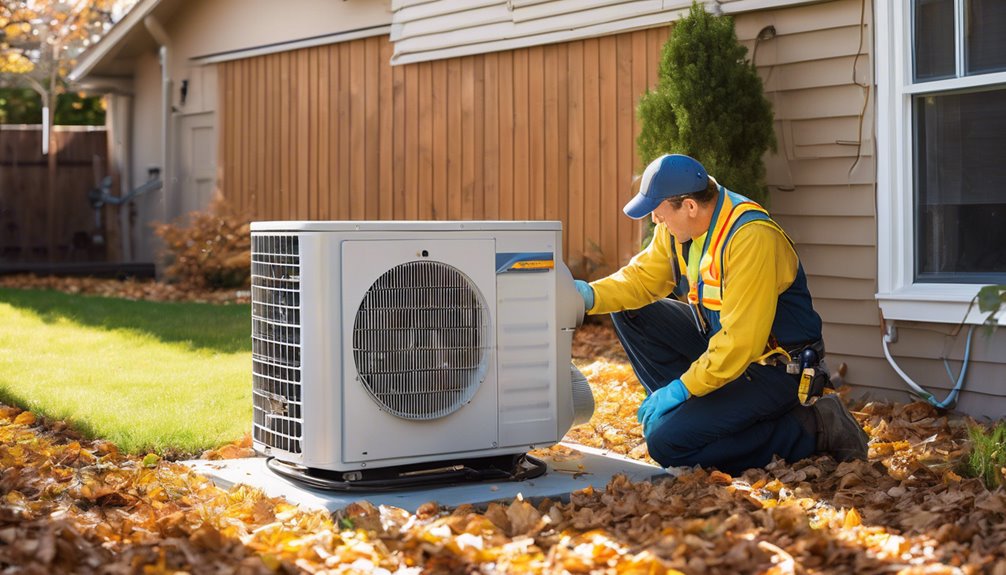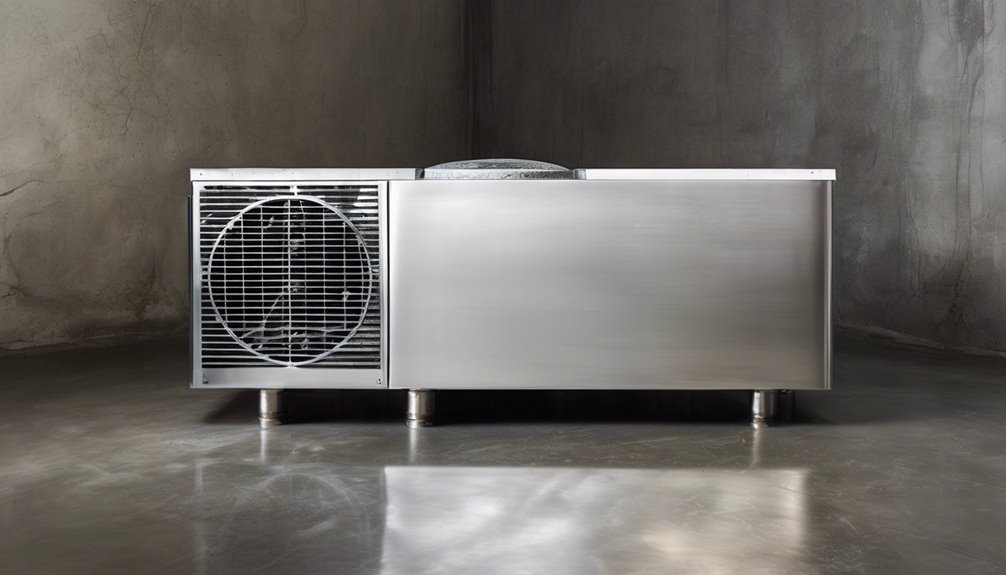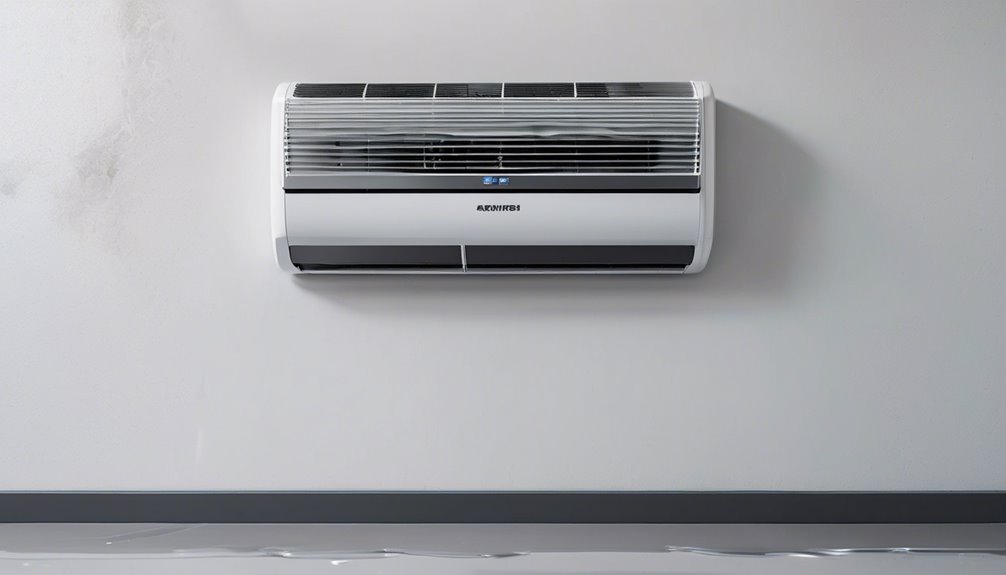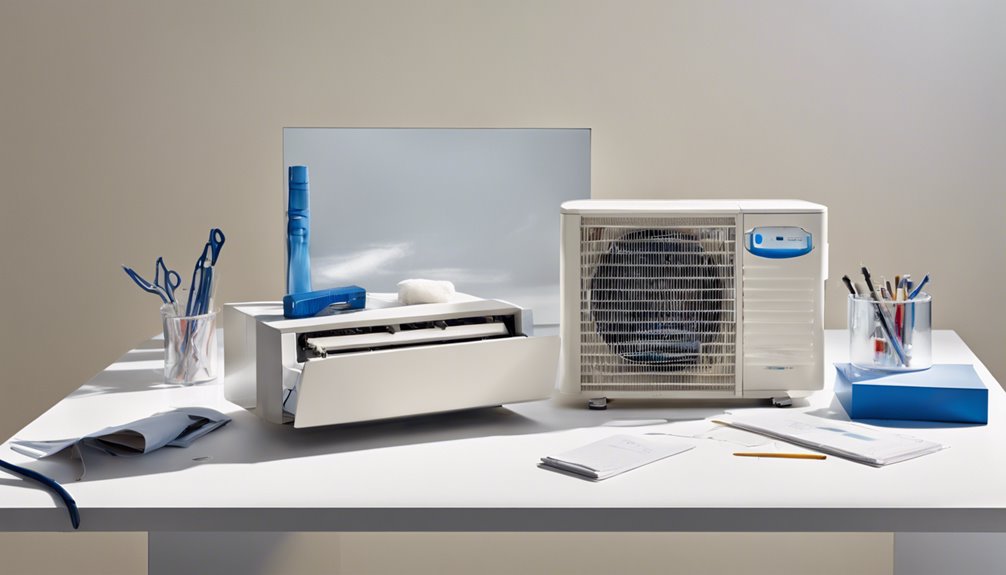When considering AC installation and replacement, you're not alone in feeling overwhelmed by the numerous options and factors to consider. To get it right, you need to determine your cooling capacity needs based on your home size, insulation, and windows. Then, you can choose the perfect AC unit, considering energy efficiency, noise level, and smart technology integration. Before installation, ensure a safe working environment, obtain necessary permits, and prepare the site. By doing so, you'll be on your way to a smooth installation process and a comfortable, energy-efficient home – and there's more to explore to get the most out of your new AC system.
Key Takeaways
- Determining the correct AC size and type depends on factors like home size, insulation, windows, and climate to ensure efficient cooling and energy savings.
- Choosing the right AC unit involves considering energy efficiency, noise level, smart technology integration, and features like air purification or dehumidifying capabilities.
- Proper installation safety precautions include avoiding electrical hazards, falling objects, and ensuring a clear workspace to mitigate risks and ensure a smooth process.
- Replacing an old AC unit with a high-efficiency system can unlock energy savings potential, reduce environmental impact, and improve indoor air quality.
- Regular maintenance tasks like replacing air filters, cleaning coils, and checking refrigerant leaks are essential for the AC system's performance, longevity, and energy efficiency.
Understanding Your AC Needs
When choosing an air conditioning system, it's essential to understand your specific cooling needs.
You'll want a system that provides summer comfort without breaking the bank. To determine the right cooling capacity, consider the size of your home, insulation, and windows.
If you live in a hot and humid climate, you'll need a more powerful system to keep your home cool. Think about how many rooms you need to cool and how often you'll be using the AC.
Will you be running it all day or just during peak hours? Answering these questions will help you determine the perfect cooling capacity for your home, ensuring you stay comfortable all summer long.
Choosing the Right AC Unit
Now that you've determined your cooling needs, it's time to select the perfect AC unit for your home.
Consider the AC features that matter most to you, such as energy efficiency, noise level, and smart technology integration. Research top AC brands like Lennox, Trane, and Carrier to find the best fit for your budget and preferences.
Look for units with high seasonal energy efficiency ratings (SEER) and energy star certifications to ensure you're getting the most bang for your buck. Additionally, think about the size of the unit and whether you need any additional features like air purification or dehumidifying capabilities.
Pre-Installation Preparation
You're about to install your new AC unit, but before you start, you need to prepare the site.
First, you'll need to assess your system to ensure it's ready for the new unit, then clear the space around the installation area to prevent any obstacles or hazards.
You'll also need to perform essential electrical safety checks to avoid any potential risks.
System Assessment Needed
A thorough system assessment is crucial before installing a new AC system, as it helps identify the ideal system size, type, and configuration for your specific needs. This assessment ensures you get the right system that meets your cooling demands. During the assessment, our experts will conduct System Diagnostics to identify any existing issues and determine the required Cooling Capacity for your space.
| Assessment Step | What to Expect |
|---|---|
| System inspection | Identify existing system components and their condition |
| Load calculation | Determine the required Cooling Capacity for your space |
| Ductwork evaluation | Check for leaks, damage, or inadequacies in the duct system |
| Thermostat inspection | Check thermostat functionality and compatibility |
| Environmental factors | Consider factors like insulation, windows, and shading |
Space Clearance Essentials
Because a smooth and efficient AC installation relies on a clear and prepared workspace, it's essential to ensure your space is ready for the installation team.
You'll want to clear the area around the installation site, removing any clutter, furniture, or obstructions that could hinder the team's access. Consider space constraints, such as narrow hallways or tight corners, and plan accordingly.
Follow clearance guidelines to ensure a safe working environment. Typically, a clearance of at least 3-4 feet around the installation site is recommended.
Electrical Safety Checks
With the installation site cleared, it's time to focus on the electrical aspects of the AC installation.
You'll need to perform electrical safety checks to identify potential hazards before installing your new air conditioner. Check for faulty wiring, which can cause electrical shocks, fires, or even electrocution.
Look for signs of wear, damage, or overheating, and ensure all connections are secure. Electrical hazards can be deadly, so it's crucial to take this step seriously.
If you're unsure about what to look for or how to proceed, consider hiring a licensed electrician to inspect your electrical system. Their expertise will give you peace of mind and ensure a safe installation.
The Installation Process
You're now ready to start the installation process, but before you begin, make sure you've completed the site preparation checklist to ensure a smooth and efficient installation.
You'll also want to take installation safety precautions to avoid any potential risks or hazards.
Site Preparation Checklist
Before diving into the AC installation process, ensure your site is prepared to avoid potential issues and delays.
You'll want to identify any site constraints that could impact the installation. This includes determining if there's sufficient space for the AC unit, as well as access for the installation team and their equipment.
Additionally, you'll need to obtain any necessary permits required by local authorities. Don't assume you don't need one – failing to secure permit requirements can result in costly fines or even project shutdowns.
Take the time to review local regulations and obtain the necessary permits before proceeding with the installation. By doing so, you'll avoid unwanted surprises and ensure a smooth installation process.
Installation Safety Precautions
During the AC installation process, your safety is paramount, and it's crucial to take necessary precautions to avoid accidents and injuries. You must be aware of potential electrical hazards, such as exposed wiring or loose connections, and follow established installation protocols to mitigate these risks.
| Hazard | Precaution | Protocol |
|---|---|---|
| Electrical shock | Ensure power is turned off | Verify with a voltage tester |
| Falling objects | Secure tools and materials | Use a tool belt or storage |
| Slip, trip, or fall | Clear the work area | Remove tripping hazards |
| Respiratory issues | Wear a dust mask | When handling insulation or debris |
Replacing an Old AC Unit
Replacing an old AC unit is a crucial step in maintaining a comfortable and energy-efficient living space.
You've likely noticed your old unit isn't performing as well as it used to, and it's time to consider replacing it.
Take a look at your AC history – how old is your current unit? Has it been properly maintained over the years?
Old units can increase your energy bills and even pose health risks due to poor air quality.
Upgrading to a High-Efficiency System
When you upgrade to a high-efficiency AC system, you'll unlock significant energy savings potential, which translates to lower utility bills each month.
This not only benefits your wallet but also reduces your environmental impact, making it a win-win. By choosing a high-efficiency system, you're taking a step towards minimizing your carbon footprint and creating a more sustainable future.
Energy Savings Potential
By upgrading to a high-efficiency AC system, you can unlock significant energy savings potential.
Conducting energy audits will help you identify areas of improvement and pinpoint opportunities to maximize energy efficiency.
Installing smart thermostats is another key step in optimizing your system's performance. These advanced thermostats learn your schedule and preferences to ensure your AC system is running only when needed, reducing waste and saving you money.
With a high-efficiency system and smart thermostat, you'll be able to enjoy a more comfortable home while minimizing your environmental impact. By making these upgrades, you'll be well on your way to reaping the benefits of a more efficient and cost-effective cooling system.
Lowering Utility Bills
You can significantly lower your utility bills by upgrading to a high-efficiency AC system.
By doing so, you'll be able to track your bill's fluctuations more accurately, identifying areas where you can make adjustments to save even more.
For instance, you can make seasonal adjustments to your cooling habits, such as raising the thermostat during warmer months or using zoning systems to cool only occupied areas.
With a high-efficiency system, you'll be able to optimize your energy consumption and reduce waste.
This means you'll not only save money on your utility bills, but you'll also reduce your carbon footprint.
Environmental Impact Reduction
Upgrading to a high-efficiency AC system is a crucial step in reducing your environmental impact. By making the switch, you'll not only lower your utility bills but also decrease your carbon footprint. Eco-friendliness is at the forefront of modern AC design, and high-efficiency systems are leading the charge.
| System Type | SEER Rating | Environmental Benefits |
|---|---|---|
| Traditional AC | 10-15 | Limited eco-friendliness, high energy consumption |
| Mid-Efficiency AC | 16-18 | Moderate eco-friendliness, reduced energy consumption |
| High-Efficiency AC | 19-23 | Significant eco-friendliness, minimal energy consumption |
| Premium AC | 24+ | Maximum eco-friendliness, near-zero energy consumption |
Ensuring Proper Sizing and Configuration
Properly sizing and configuring your air conditioning (AC) system is crucial to ensure it operates efficiently and effectively.
When selecting an AC system, you'll need to determine the right AC capacity for your space. This depends on various factors, including the size of your home, number of windows, insulation, and cooling requirements.
A system that's too small won't cool your space adequately, while one that's too large will waste energy and increase your utility bills. You'll need to calculate your cooling requirements to determine the correct AC capacity.
Consider factors like the number of people occupying the space, humidity levels, and the type of windows and insulation used. By getting the sizing and configuration right, you'll enjoy optimal cooling performance and energy efficiency.
Connecting and Testing the System
With the AC system's components selected and configured, it's time to bring them together by connecting the system.
You'll need to hook up the thermostat, connect the wiring, and attach the condenser coils. Make sure to perform thorough wiring inspections to ensure there are no loose connections or exposed wires.
Next, you'll need to perform system calibration to optimize the AC's performance. This involves setting the thermostat, adjusting the refrigerant flow, and fine-tuning the fan speed.
After connecting and calibrating the system, turn it on and test it to ensure it's working efficiently and effectively. If everything checks out, you're ready to move on to the next step.
Post-Installation Maintenance and Care
Your newly installed AC system is now up and running, but its performance and longevity depend on regular maintenance and care. To ensure your system runs efficiently and effectively, you'll need to perform routine tasks.
| Task | Frequency |
|---|---|
| Replace Air Filter | Every 1-3 months |
| Coil Cleaning | Every 3-6 months |
| Check Refrigerant Leaks | Annually |
| Schedule Professional Maintenance | Annually |
Signs You Need AC Replacement
As your AC system ages, it's essential to recognize the signs that indicate it's time for a replacement.
If your AC is approaching or has exceeded its expected lifespan (usually 10-15 years), it's likely losing its cooling capacity. You may notice your home takes longer to cool down or doesn't cool as efficiently as it used to.
Another sign is increased energy bills, as your AC works harder to cool your space. If you've had frequent repairs or are experiencing uneven cooling, it might be time to consider replacing your AC.
Don't wait until it breaks down completely, causing discomfort and inconvenience. Be proactive and look for these signs to ensure you stay cool and comfortable in your home.
Frequently Asked Questions
Can I Install an AC Unit Myself to Save Money?
You're thinking of going the DIY route to save some cash, but be aware that tackling a complex task yourself can lead to DIY risks, like incorrect installation, and may even result in warranty voidance, costing you more in the long run.
How Long Does a Typical AC Installation Take?
When tackling a new project, you're probably wondering how long it'll take to get everything up and running. Well, the duration depends on the unit complexity and installation complexity, but on average, a pro can get the job done in about 4-8 hours.
Do I Need to Replace My Thermostat With a New AC?
You'll need to check your thermostat's compatibility with the new AC, as an incompatible one can reduce AC efficiency. If it's old or outdated, consider replacing it to ensure optimal performance and energy savings.
Can I Reuse My Old Ac's Condenser Coil?
As you gaze out at the serpentine coils, reminiscent of a mythical hydra, you wonder if they can be reused. Unfortunately, you can't reuse your old AC's condenser coil without thorough coil cleaning and maintenance, ensuring it's free from damage and corrosion.
Will a New AC Unit Increase My Home's Value?
When you upgrade to a new, energy-efficient appliance, you'll boost your home's market appeal. In fact, you'll increase its value, as modern, eco-friendly features are highly sought after by potential buyers, making your property more attractive and desirable.
Conclusion
As you wrap up the installation or replacement of your AC unit, remember that it's not just about beating the heat, but about breathing easy – literally. A well-installed and maintained AC system is the unsung hero of your home's comfort and air quality. So, take a deep breath and enjoy the cool comfort of your new AC, knowing you've invested in a healthier, happier you.



